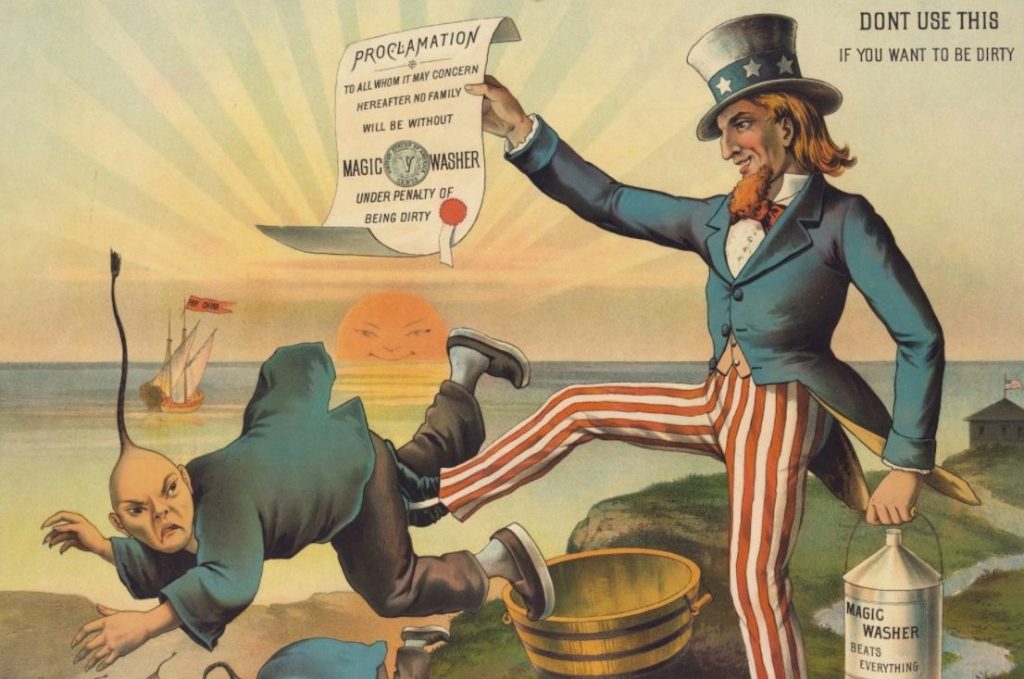With Chinese Exclusion Law (officially Immigration Act of 1882On May 6, 1882, the United States ended the immigration of Chinese to America. It was the first major federal law to restrict immigration to America to a certain nationality.

In the decades before this law was passed, millions of immigrants came to the United States. However, during the course of the nineteenth century, more and more voices emerged to limit this migration. This was in part due to the arrival of a new type of immigrant who was difficult to “Americanize”. Initially, immigrants came mainly from Great Britain and countries in Western Europe. This immigration caused relatively few problems and was very beneficial to the United States. The New Americans were relatively young, often already speaking English, complained little and were willing to work hard, even when working conditions were not very favorable. Many of them were lured to America by the big corporations, including the railroad companies, which offered them a future full of opportunity and freedom. America was the new “Land of Milk and Honey”.
But in the decades before 1882, more and more immigrants arrived from southern Europe, including many Italians, Greeks, Croats, and Slovaks. Their arrival created more problems. Many of these immigrants were relatively poor, could not read or write, and, after arriving in the United States, often congregated in shabby neighborhoods in crowded cities. The arrival of poor, unskilled Irish and Chinese labor also kept people busy. On the West Coast, for example, many American workers believed that wages had fallen due to the arrival of cheap Chinese labor. In addition, they accused the Chinese of breaching the strikes.
In 1820, the first groups of Chinese arrived in America. They were very popular with employers. The Chinese worked hard and with little money. In some places, due to labor migration, the number of Chinese rose sharply in a short period of time, especially in the 1960s. For example, in 1865, Chinese immigrants settled in Boise, the capital of the US state of Idaho. Five years later, one-third of the settlers in Idaho were already Chinese, and nearly 60 percent of the miners were Chinese. The number of Chinese immigrants elsewhere has also increased, although the proportion of Chinese in the total population has remained very limited at 0.002%.
Due to the influx of immigrants, the population has increased significantly in these years. In 1880, the population of the United States reached fifty million, an increase of ten million from ten years earlier. And in 1882, partly due to the arrival of new immigrants, the population grew by about two thousand people every day.
Distinguish
Many “Old Americans” felt more connected with European immigrants – who were not always welcomed with open arms, by the way – than with Asian newcomers, who are often seen as inferior. The distinction between Europeans and Chinese was also reflected in the legislation. Through various constitutions, American states have tried to limit the rights of Asians. For example, the 1857 Oregon Constitution prohibited Chinese from owning real estate, and California law prohibited Chinese immigrants from testifying in court. In a lawsuit in California that became known as People vs. Hall, this was confirmed again in 1854. In this case, the Chinese were described as …
“…a race of men considered inferior by nature, who, as their history has shown, are incapable of progress or intellectual development beyond a certain point.” These facts – Gilles Lepore (p. 375)
The thorn in the side of Americans who considered Chinese “inferior” and “pagan” was the fact that children of Chinese immigrants automatically acquire US citizenship if they were born on American soil. This was regulated in the Fourteenth Amendment, and this provision had no racial restrictions. Instead of a melting pot of nations, America became more and more a “garbage dump” in the eyes of the so-called “Old Americans”, who were also outraged by the arrival of the poor and criminals from Europe.
Chinese immigrants often faced hard times. Many were recruited to work in California’s gold mines or on railroads. They worked hard and with little money and had to deal with racism in America. During the economic crisis of the 1870s, for example, the Chinese were regularly beaten during riots. The “unadapted Chinese” were ambushed by angry white Americans who cut their braids. At this time, voices calling for an end to immigration from China could already be heard. However, the employers, taking full advantage of the cheap labor, were initially able to prevent this.

Chinese Exclusion Law in Jerry’s Law

But in 1882, immigration from China finally stopped. In California in particular, people made a strong case for this station, with many Chinese workers moving there privately. The Chinese Exclusion Act suspended immigration from China for ten years. US President Chester A. Arthur Act on May 6, 1882. An amendment to the law shortly thereafter also stipulated that Chinese immigrants who had temporarily returned to China would not be allowed to return to the United States.
The passage of the law is a focal point of the United States’ approach to immigration. Until then, America had the image of the “Land of Unlimited Possibilities” and was known as the place where all immigrants were welcome and where everyone could become an American, America is now stricter and more conditions are imposed on American citizenship.
In 1892, with the adoption of the so-called Jerry’s Act, the scheme was extended for ten years. The threads were tightened a little more. Chinese on US soil are now required to carry identification papers at all times. Anyone who cannot show these documents is at risk of deportation. In 1902 the Chinese Exclusion Act was extended for the second time and in 1904 the immigration ban became permanent.
repeal the law
With the passage of the Magnuson Act, the law was repealed in 1943. From that moment on, immigration from China was again possible, albeit on a very limited scale. Up to 105 immigrants from China are welcomed each year. Quotas have also been set for immigrants of other nationalities.
Also interesting: Statue of Liberty – A much discussed woman
…employment: Before Europe became a fortress
…from: What is a creeper? Meaning and origin
Resources
-https://www.britannica.com/topic/Chinese-Exclusion-Act
Hess America – Gilles Lepore (pp. 68, 70)
-history.com/topics/immigration/chinese-exclusion-act-1882
These facts – Gilles Lepore
– American History in a nutshell – Jan van Audehusden (Bert Bakker, 2009) – pp. 68-69
-https://en.wikipedia.org/wiki/Chinese_Exclusion_Act
– A History of Humanity – Aart Aarsbergen ea – p. 928


